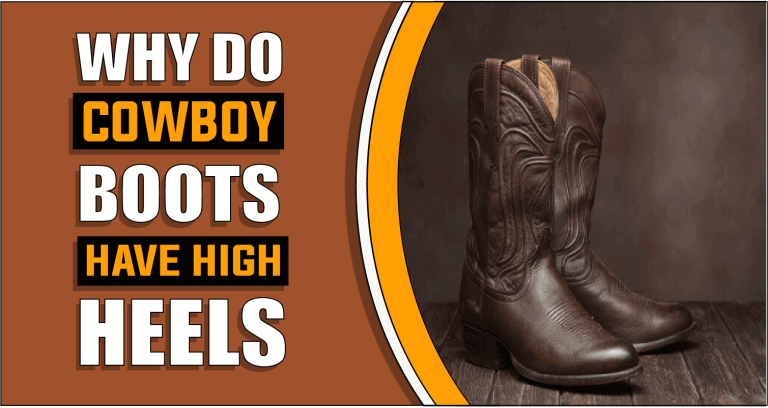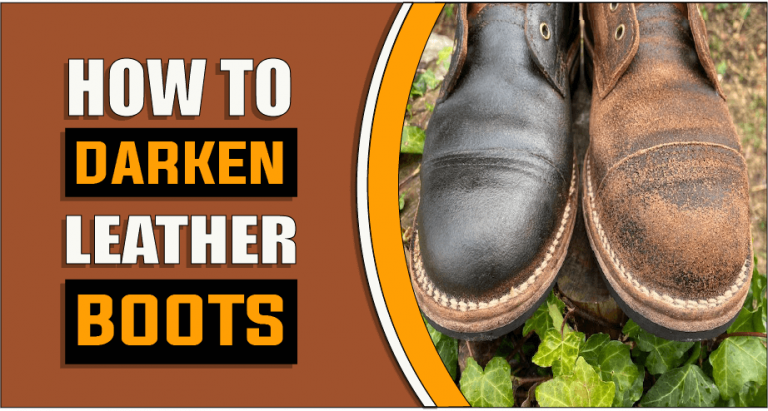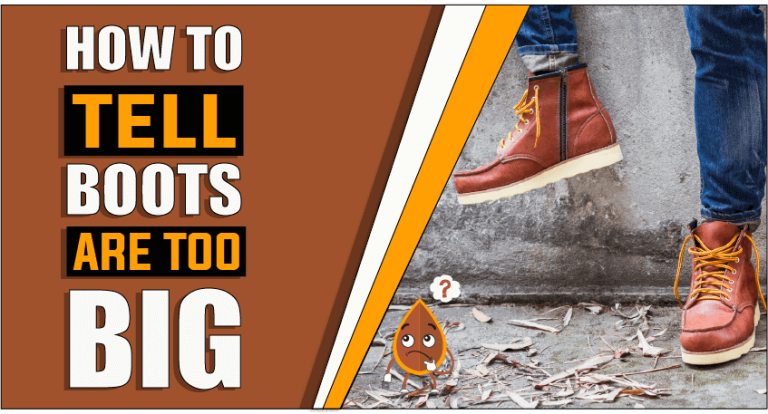Why do Cowboy Boots have Heels – Know Before You Wear
If you’re looking for a boot that is full of character and history, you may consider cowboy boots. These iconic pieces of western wear have been around since the 1800s, and are the perfect choice to add some style to your wardrobe. But have you ever wondered why cowboy boots have heels? Many have pondered this question over the years, but few people have looked further into it to answer their questions. From practical considerations such as traction in stirrups and grip on rough terrain to fashion statements used by cowboys and others throughout history, there are many reasons why cowboy boots come with heels. Through our detailed comparison, we will explore all of these points so that you can better understand why cowboy boots have heels. Whether they’re made from exotic leathers or traditional materials like leather or canvas, readers are sure to check out our comprehensive discussion about the legendary cowboy boot!

Let’s explore why cowboy boots have heels
Cowboy boots have become a fashion staple for many people. The classic boot style has been co-opted by everyone from ranchers to rockers, and its iconic silhouette is recognizable around the world. One of the most distinctive features of cowboy boots is their heels, which can range in height from half an inch to two inches. So why do cowboy boots have heels? Cowboy boots have heels for a variety of reasons, all of which are beneficial to the wearer.
1: Stability:
The most obvious reason for having a heel on cowboy boots is that it provides the wearer with greater stability. While walking in flat-soled shoes or boots, your foot can easily slip off to one side or another. This can be particularly dangerous if the terrain you’re traversing is uneven or slippery. The heel on cowboy boots gives you an extra bit of traction, keeping your foot in place and reducing the risk of a dangerous slip or fall.
2: Protection:
The heel on cowboy boots also serves as a protective barrier between your foot and the ground. By raising your heel slightly off the ground, your boot acts as a buffer against sharp stones or other potential hazards. This can be especially important when you’re riding a horse, as the additional layer of protection can help to prevent injury.
3: Comfort:
Another reason for having heels on cowboy boots is that it adds a level of comfort to the boot. The raised heel helps to relieve pressure on your foot by redistributing your body weight more evenly across the sole of your boot. This helps to reduce fatigue and pain, making it easier to wear your boots for extended periods. Ultimately, the heel of a cowboy boot provides countless benefits and is an essential part of the classic design. The combination of stability, protection, and comfort makes cowboy boots with heels a great choice for anyone looking for fashionable and functional footwear. Whether you’re a cowboy, a fashionista, or just someone who appreciates the classic look of cowboy boots, you can be sure that their iconic style will remain timeless for years to come. And when you slip on that pair of cowboy boots with the perfect heel height, you’ll understand why they’re so popular.
How Many Different Kinds of Cowboy Boot Heels Are There?
When it comes to cowboy boots, the heel is an important part of the overall style and design. Cowboy boot heels come in a variety of styles, depending on their purpose – from work boots to dress boots, western-style fashion to weekend wear. Here, we discuss the different kinds of cowboy boot heels that are available today.
1: Traditional Cowboy Heel:
The classic cowboy heel, also known as the walking heel or roper heel, is the standard for most western-style boots. It has a low profile and provides a secure footing while walking or riding a horse. This type of heel is typically 1 to 2 inches in height and slightly sloping upward at the back.
2: Stockman Heel:
The stockman heel is a thicker, sturdier version of the traditional cowboy heel. It has a more solid feeling and offers better arch support when walking or riding. This type of heel is usually 1 to 2 inches in height, with a square-shaped profile that’s slightly wider at the back.
3: Dress Heel:
The dress heel is a taller, more elegant version of the cowboy boot. It usually has a curved shape that’s slightly raised at the back and provides a greater degree of stability. These heels range in height from 2 to 3 inches, making them suitable for formal occasions.
4: Riding Heel:
The riding heel is designed to provide extra comfort when riding a horse. It has a taller, rounded shape and typically measures 3 to 4 inches in height. This type of heel helps keep the foot firmly in place while also providing additional stability.
5: Work Heel:
A work heel is designed for use during labor-intensive activities such as farming, ranching, or construction work. It’s usually 1 to 2 inches in height and slightly sloped downward at the back for extra stability when working in a bent-over position.
6: Western Fashion Heel:
The western fashion heel is designed for style rather than function. It has a higher profile and can range from 3 to 4 inches in height. This type of heel is designed to enhance the look of a pair of cowboy boots and is often used in combination with other styles such as the dress heel or riding heel.
No matter what type of cowboy boot you choose, there are a variety of heels to choose from that will help you make a statement. Knowing the different styles of cowboy boot heels can help you find a pair that’s both functional and fashionable.
How Tall Are Cowboy Boots Heels?
Cowboy boots come in a variety of styles and heights. The most common cowboy boot heel heights are 1 inch, 1 1/2 inches, and 2 inches. However, other heel heights may be available depending on the manufacturer or style. It is important to consider several factors before choosing the right cowboy boot height for you.
1: The activity you will be doing while wearing the boots.
Cowboy boots should provide stability and support for the activities they are intended for, so heel height is an important factor in choosing the right boot. For instance, if you plan on horseback riding or participating in other outdoor activities, a higher heel may provide more balance and stability than a lower heel would.
2: The overall style of the boot.
Heels can range from low and flat to quite high, so depending on your personal preferences or desired look, you may want to opt for a higher or lower heel. For instance, if you are looking for a classic cowboy boot with a more traditional look, you may want to stick with a 1 or 1 ½ inch heel.
3: The occasion for which you are wearing the boots.
If you are attending a rodeo, a higher heel may be more appropriate than if you were simply going out to dinner. Heels can also add an extra bit of style and flair to any outfit, so consider how high you want your boots to be when selecting the right pair.
No matter which heel height you choose, it is important to make sure that your boots fit properly and provide adequate support and stability. When trying on the boots, walk around in them to get a feel for how they fit and move on different surfaces. This will help ensure that your cowboy boots are both comfortable and stylish. By considering the activity, overall style, and occasion for which you are wearing the boots, you can easily select the right cowboy boot heel height for your needs. Once you have found a pair of boots that fit both your feet and style preferences, enjoy wearing them in comfort and confidence!
Which type of heel should I wear?
When it comes to choosing a heel for an outfit, there are many factors to consider.
1: The occasion:
The type of heel you wear should match the occasion. For a formal event, it is best to opt for a classic pump, kitten heel, or stiletto. If you’re going to a casual lunch or dinner, choose something more off-duty like wedges, mules, or flats.
2: Your outfit:
Think about the other elements of your outfit when selecting a heel. If you’re wearing something more fitted or structured, like tailored trousers and a blazer, pair it with a classic shoe such as a pump or stiletto for balance. Conversely, if you’re wearing an oversized t-shirt dress or jeans and trainers, opt for chunky block heels to contrast the look.
3: Comfort level:
When deciding on a heel, it’s important to consider your comfort level. If you’re new to wearing high heels, opt for wedges or chunky block heels as they provide more stability and support than stilettos. If you’re used to wearing heels, you can opt for something more daring like mules or ankle strap sandals. Ultimately, the type of heel you choose should reflect your style and be comfortable enough for you to wear throughout the day or night.
4: Shoes for the season:
Different materials and heel shapes are better suited for certain seasons. For example, open-toe sandals or slingbacks with a lower heel work well in warmer weather, while closed-toe pumps or boots are more suitable for cooler months.
No matter the type of heel you choose, make sure to take regular breaks if your feet start to hurt and wear comfortable insoles. With the right style selection and care, you can walk in confidence and comfort no matter the occasion!
What Materials Are Used to Make Cowboy heels?
Cowboy heels have been a staple of western fashion for centuries. They are typically made from either leather or rubber and feature a low, wide heel that creates an iconic look.
1: Leather-
Leather is the traditional material used to craft cowboy heels, with variations in color and texture depending on the grade of leather used. These boots can be treated to increase their durability and longevity, making them a good choice for those who want to invest in a timeless look that will last for many years.
2: Rubber-
Rubber is more commonly used in the manufacturing of modern western boots, as it is both lightweight and durable. It doesn’t offer quite the same range of style options as leather does, but it is a good choice for those who are looking for something more affordable and functional. Many rubber cowboy boots will feature a faux leather finish to create a classic look.
3: Synthetic Materials-
Synthetic materials such as PVC and polyurethane are becoming increasingly popular for cowboy boots, as they offer good durability without the need for regular maintenance or care. Synthetics can also be molded into various shapes to create more contemporary looks, which many people find appealing.
No matter what type of material you choose, your cowboy heel should be well-constructed and comfortable. Leather or rubber cowboy heels are the most traditional, but synthetic materials can also provide a good option for those looking for something more modern and practical. Whichever material you choose, make sure it is high quality and provides maximum comfort and durability. This way, your boots will last longer and look great.
Can You Replace The Heel On Cowboy Boots?
Replacing the heel on cowboy boots is a surprisingly simple task that requires little in the way of tools or materials.
What you need-
You will need the following items to replace the heel on cowboy boots:
- A replacement heel of the same size and shape as the original. You can purchase these heels in most major shoe stores or online.
- Glue designed specifically for leather, such as Fiebing’s Leather Cement
- A putty knife
- A rubber mallet or hammer
- Painter’s tape, masking tape, or duct tape
How to replace the heel on cowboy boots-
Step 1: Preparing the boot-
Begin by preparing the heel of your cowboy boot. Use painter’s tape, masking tape, or duct tape to cover the area around where the new heel will be placed. This helps prevents any glue or debris from staining the leather.
Step 2: Applying glue-
Using the putty knife, spread a liberal layer of the leather cement onto the bottom of the new heel. Once you have applied enough glue, use the putty knife to carefully spread it evenly all over the underside of the heel.
Step 3: Attaching the heel-
Carefully position the new heel against your boot and press down firmly. If the heel does not stay in place, use a rubber mallet or hammer to lightly tap it into position.
Step 4: Allow time to dry-
Once the heel is in place, you will need to allow it to dry entirely. This can take up to 24 hours depending on how much glue you used. Finally, once your boot has had time to dry entirely, it is ready for wear!
With just a few simple steps and some common tools, you can easily replace the heel on cowboy boots. Not only will it make your boots look like new, but it can also provide extra support and comfort when walking. So go ahead and give it a try!
Relevant Questions:
Boot heels serve several purposes. First, they provide stability and support to the foot while walking or standing. Additionally, boot heels help protect the feet from external elements such as water, mud, and rocks. Finally, a heel on a boot can also add to the aesthetics of an outfit and make it look more stylish. The type of heel used will depend on the material of the boot, as well as the desired look. For example, a heeled leather boot can be more formal than a heeled rubber one. Boot heels come in different shapes and sizes, so it’s important to choose the right style for your needs. Ultimately, the purpose of a boot heel is to provide stability, protection, and a fashionable look.
Yes, the heel of your cowboy boots should come up and provide good support for your feet. This helps to prevent fatigue and other issues that can occur due to improper footwear. It’s important to choose the right size cowboy boot and make sure it fits correctly; this will ensure that the heel comes up enough to provide adequate support while still looking stylish.
Cowboy boots are a symbol of the American West and its ranching culture. They’re designed to be durable and comfortable, providing cowboy-style protection from harsh conditions like extreme temperatures, rough terrain, and hazardous weather. Cowboy boots also come in an array of fashionable styles that not only protect but look great. Whether you’re hitting the trails, hitting the town, or just looking for a way to express yourself, cowboy boots offer something for everyone. Cowboy boots are also said to provide better support and performance than regular-style shoes because of their higher shafts and pointed toes. If you have trouble finding stylish footwear that can keep up with your active lifestyle, consider investing in a pair of classic cowboy boots. You won’t be sorry!
Cowboy boots are designed to be slipped on and off easily, so they typically have no tread or ridges on the sole. This allows them to slide smoothly against the ground when the wearer walks, rides a horse, or enters a dance hall. Additionally, cowboy boots’ lack of tread helps protect their leather soles from wear and tear. The ridgeless design also makes them more fashionable, as they look sleek and polished when paired with jeans or other western wear. Ultimately, the lack of tread on cowboy boots is intentional and is a key part of their iconic style.
Conclusion Paragraph
All in all, cowboy boots have heels for a variety of reasons. Whether it’s to just make them appear more stylish or to help riders stay better balanced while riding their horses, the reasons why they have heels make perfect sense. Rocking a pair of cowboy boots today doesn’t require you to have excellent horse-riding skills; nevertheless, whichever uses attract you to rope in a pair of cowboy boots, we are sure that you will feel completely comfortable and fashionable at the same time. With this article, we hope you now understand why cowboy boots have heels and appreciate the history behind them even further.
Ella John created BootsSolution.com with the vision of helping people to find the perfect boots for any occasion. As an expert in the field of footwear, she has created a comprehensive guide to finding the perfect boots. With her BA (Hons) in Footwear Design from De Montfort University, UK, Ella John has been writing about boots for several years. On BootsSolution.com you can find helpful information about the latest trends, tips for taking care of your boots, and advice on how to choose the right pair. Ella’s mission is to provide her readers with the best possible advice and help make sure that everyone can look their best in a perfect pair of boots. So if you’re looking for the information and inspiration you need to find the perfect boots, look no further than BootsSolution.com.






